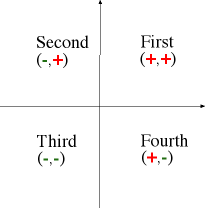Let A and B be two vectors which are represented by two directed lines OM and ON respectively. The vector B is added to A by the head to tail rule of vector addition (fig 2.9). thus the resultant vector R = A + B is give, in direction and magnitude, by the vector OP.
In the Fig 2.9 , ![]() and are the x components of the vectors A, B and R and their magnitudes are given by the lines OQ, MS, and OR respectively, but
and are the x components of the vectors A, B and R and their magnitudes are given by the lines OQ, MS, and OR respectively, but

Which means that the sum of the magnitudes of x-components of two vectors which are to be added, is equal to the x-component of the resultant. Similarly the sum of the magnitudes of y-components of two vectors is equal to the magnitude of y-component of the resultant, that is
Since ![]() and are the rectangular components of the resultant vector R, hence
and are the rectangular components of the resultant vector R, hence

The magnitude of the resultant vector R is thus given as
And the direction of the resultant vector is determined from

Similarly for any number of coplanar vectors A, B, C…….. we can write

Do you know?
 The Chinese acrobats in this incredible balancing act are in equilibrium.
The Chinese acrobats in this incredible balancing act are in equilibrium.
The vector addition by rectangular components consists of the following steps.

- Find x and y components of all given vectors.
- Find x-component
 of the resultant vector by adding the x-component of all the vectors.
of the resultant vector by adding the x-component of all the vectors. - Find y-component
 of the resultant vector by adding the y-components of all the vectors.
of the resultant vector by adding the y-components of all the vectors. - Find the magnitude of resultant vector R using

- Find the direction of resultant vector R by using
![]()
where is the angle, which the resultant vector makes with positive x-axis. The signs of ![]() and
and ![]() determine the quadrant in which resultant vector lies. For that purpose proceed as given below.
determine the quadrant in which resultant vector lies. For that purpose proceed as given below.
Irrespective of the sign of ![]() , determine the value of
, determine the value of ![]() from the calculator or by consulting trigonometric tables. Knowing the value of ф, angle θ is determined as follows.
from the calculator or by consulting trigonometric tables. Knowing the value of ф, angle θ is determined as follows.
- If both
 are positive, then the resultant lies in the first quadrant and its direction is θ = ф.
are positive, then the resultant lies in the first quadrant and its direction is θ = ф. - If is
 – ive and
– ive and  is +ive, the resultant lies in the second quadrant and its direction is θ = 180⁰ – ф.
is +ive, the resultant lies in the second quadrant and its direction is θ = 180⁰ – ф. - If both
 are –ive, the resultant lies in the third quadrant and its direction is θ = 180⁰ – ф.
are –ive, the resultant lies in the third quadrant and its direction is θ = 180⁰ – ф. - If
 is positive and
is positive and  is negative, the resultant lies in the fourth quadrant and its direction is θ = 360⁰ – ф.
is negative, the resultant lies in the fourth quadrant and its direction is θ = 360⁰ – ф.

Example 2.2: two forces of magnitude 10 N and 20 N act on a body in direction making angles 30⁰ and 60⁰ respectively with x-axis. Find the resultant force.
Solution:
Step (i) x-components
The x-component of the first force : ![]() cos 30⁰
cos 30⁰
= 10 N x 0.866 = 8.66 N
The x-components of second force = ![]()
= 20 N x 0.866 = 17.32 N
Step (ii)
The magnitude of y component ![]() of the resultant force F
of the resultant force F

Step (iii)
The magnitude of y component ![]() of the resultant force F
of the resultant force F

Step (iv)
The magnitude F of the resultant force F
Step (v)
F the resultant force F makes and angle θ with the x-axis then
Example: 2.3: find the angle between two forces of equal magnitude when the magnitude of their resultant is also equal to the magnitude of either of these forces.
Solution: let θ be the angle between two forces F1 is along x-axis. Then x-component of their resultant will be

And y-component of their resultant is


Point to ponder
Why do you keep your legs far apart when you have to stand in the aisle of a bumpy-riding bus?
